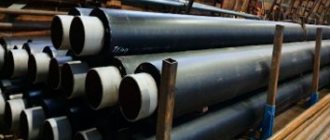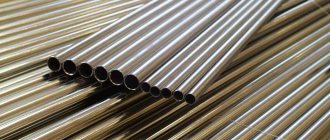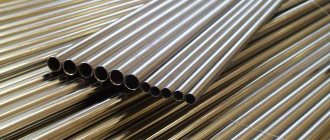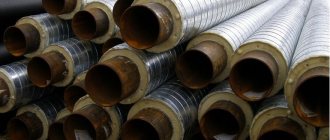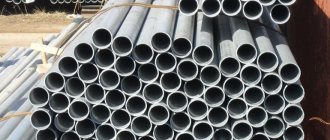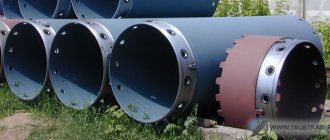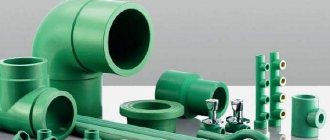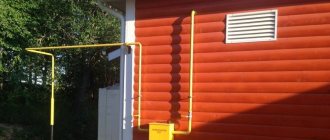Heat losses are a vast problem familiar to everyone, which is accompanied by a waste of energy resources, heat, and money. Such losses are enough to make you think about it and take effective measures to prevent them. Today, many technologies for saving heat using thermal insulation materials have been developed and successfully applied.
Pipes in polyurethane foam insulation are a modern material for the installation of heating mains, water pipelines and other highways
What is PPU insulation?
Polyurethane foam pipe insulation (PPU) is a two-layer coating consisting of a foam-like plastic heat insulator - polyurethane foam (its elastic modification is called foam rubber) covering the pipe and an outer shell of high-density polyethylene (HDPE) as protection. There are options in three layers, two cortical layers of polyethylene and polyurethane foam between them. The coating has no longitudinal seams or joints. The effectiveness of such insulation is recognized throughout the world and is considered one of the best ways to avoid heat loss from a pipeline. Its main tasks are: maintaining the integrity of the pipe (protection from corrosion, damage) and reducing thermal conductivity. The thermal conductivity coefficient of insulation varies between 0.025 - 0.032 W/(m K) (mineral wool - 0.070 W/(m K), glass wool - 0.050 W/(m K)).
The main component of the insulating coating is polyurethane foam. This is a plastic obtained from products of the petrochemical industry and consists of 80-95% gas filling a fine-mesh structure. The rest of the plastic volume is occupied by the walls of cells isolated from each other, which make up the rigid frame of the foam. It is this composition of polyurethane foam that is widely used in construction work due to its properties:
- lack of thermal conductivity;
- high adhesion to various types of surfaces;
- very light, strengthens the pipe without weighing it down;
- operating temperature from -180°C to 200°C, metal pipe in polyurethane foam insulation can be operated in conditions from -85°C to 140°C;
- coolant temperature 130°C – 150°C;
- integrity of the coating without joints and seams during spraying;
- excellent insulating qualities, waterproof, moisture absorption 1% per day of the initial volume;
- resistance to aggressive environments of acids, alcohols, petroleum products, chemical vapors and ethers;
- soundproofing;
- no caking, corrosion, rotting, or fungal infection. PPU insulation reduces the corrosion process of the metal system by tens of times;
- low flammability due to phosphorus-containing and halogen fillers, has three groups: C - self-extinguishing, TV - fire-resistant, TC - fire-resistant;
- environmentally friendly, safe after hardening, since during spraying a large number of particles are concentrated in the air. The release of carbon monoxide begins when heated to 600°C;
- service life 30+ years.
The polyurethane foam insulating layer is located midway between the working pipe and the outer protective coating
Production of pipes in polyurethane foam insulation
Enterprises specializing in the production of pipes, thanks to the installation of a filling line for the production of polyurethane foam casings, provide a full cycle of products, reducing their cost. Manufacturing is accompanied by strict compliance with GOST and control of all stages of production. The pouring process itself is quick and economical; the insulated pipe becomes a cast one-piece structure. The polyurethane foam layer does not involve the use of a large amount of the starting material. To do this, proportionally balanced liquid components (polyol and polyisocyanate) are supplied under pressure into the void between the pipe and the outer cortical HDPE shell. There the components harden to form a layer of insulation. In this case, complete adhesion of the contacting materials occurs.
Before this, the surface of the steel pipe is shot blasted, then it is externally equipped along its entire length with several centering support rings made of polyethylene and a cable for remote leakage monitoring (RTC), and special plugs are installed at the ends of the pipe. One PPU shell can accommodate from 1 to 6 pipes (multi-pipe engineering systems).
The protective HDPE coating is suitable for laying the pipeline in the ground to a depth of 2 m to 8 m. The external (air) line is covered with a layer of galvanized steel. Based on the thickness of polyurethane foam insulation, they come in two types: type 1 – standard (moderate latitudes) and type 2 – reinforced (latitudes with frosty climates).
GOST 30732-2006: standard design PPU PE
PPU products are assembled using the “pipe-in-pipe” principle: liquid thermal insulation is injected into the gap between the steel base and the polyethylene shell. The components harden in the interpipe space, filling all gaps. To improve adhesion, steel pipes are pre-treated with a shot blasting unit and coated with protective compounds. Adhesion of polyurethane foam to the PE shell is ensured by a coronary electrical discharge.
Under the cover layer, signal lines of the UEC system are installed, made of bare copper grade MM (cross-section - 1.5 mm). 2 conductors are built into products with a diameter of up to 426 mm, and 3 conductors are built into pipes with a diameter of 530 mm or more. The indicators are located parallel to the axis of the base. Signal lines allow you to quickly detect and eliminate leaks on the heating main.
PPU and PPM insulation
Polymer-mineral thermal insulation (PPM) is also produced on the basis of rigid polyurethane foam, slightly changing the composition by adding fine mineral fillers (sand, ash). The result is a durable coating with the properties of polymer concrete and polyurethane foam, which significantly reduces the consumption of incoming components and costs while increasing mechanical and thermal characteristics.
PPM insulation is a cheaper, but no less effective material than polyurethane foam
PPM insulation is also made in three layers, but all layers are made of a homogeneous composition of different densities. The first outer layer is high-strength 10-15 mm with a density of 400-600 kg/m3, which allows you to maintain the integrity of the entire insulation, is resistant to mechanical damage, loads and is waterproof. The second, more porous layer can be of different thicknesses, depending on heat loss indicators, with a density of 80-200 kg/m3. The third 5-10 mm, with a density of 300-400 kg/m3, is adjacent to the pipe, reliably protecting it from corrosion.
Insulated PPU PPM pipes when used as heating networks showed the comparative characteristics presented in the table.
Table 1
| Index | PPU | PPM |
| Thermal conductivity, W/(m K) | 0,025 – 0,032 | 0,041 – 0,044 |
| Coolant temperature, оС | 150 | 150 |
| Volumetric mass (density), kg/m3 | 60 | 350 |
| Compressive strength, MPa | 0,15 – 1 | 1,5 |
| Bending strength, MPa | 0,35 – 1,5 | 0,5 |
| Water absorption,% | 1 | 0,5 |
| Adhesion, MPa | 0,12 | 0,49 |
| Depth of damage when applying a blow with energy of 14 J to the outer layer (dent, scratch), mm | 2 – 2.5 polyethylene | 2,5 – 2,8 |
| Service life, years | >30 | >30 |
Pipes in polyurethane foam insulation have lower thermal conductivity, and to reduce this indicator, for products with polyurethane foam, the thickness of the middle layer increases by 15-25%. The water absorption of both coatings is completely negligible, thus the steel pipe is completely protected from oxidation. This is evidenced by studies of samples of heating networks operated under normal conditions over a 20-year period. After removing the insulation, the outer surface of the steel pipeline retained its integrity.
There is a problem of moistening the joint zone at the boundaries of the PPM insulation; when filling the joints, it is not possible to achieve absolute solidity, and this leads to water seeping into the metal pipe. This factor can be eliminated by the vapor permeability of the PPM (the ability to dry after getting wet), but only during the period of movement of the coolant under the condition of channel installation. When laid in soil whose humidity is variable, drying will not occur without additional heating.
Pipes in polyurethane foam insulation are equipped with the UEC system, which allows you to control the humidity of the insulating layer
The presence of leaks in the pipeline due to defects in the walls and pipe seams greatly reduces the thermal insulation properties of the PPM, while the tightness monitoring system installed in the polyurethane foam shell (electrical conductivity changes due to the excess moisture level of the insulation) makes it possible to detect the slightest leak and carry out repairs, thereby preventing further emergencies.
Important! The porous structure of PPM (25% of the entire coating surface) in conditions of wet salt-containing soil reduces the corrosion rate of a steel pipe by four times, while the anti-corrosion properties in tap water conditions are 100 times higher. At 45°C, salt liquid from the soil reaches the steel surface in a period not exceeding one day.
Compared to polyurethane foam, PPM insulation has such qualities as ease of repair and installation work. The damaged section of the pipe is repaired without the use of fittings; the joints are filled with insulating components, which can be prepared directly at the repair site. All work is carried out without removing the entire pipe, which significantly reduces costs.
The main advantage of PPM is its strength. The cortical layer does not contain voids or cavities, withstands loads and damage, significantly increasing the durability of the pipeline. Air laying requires UV protection by applying light reflective paint.
Assortment of pipes in polyurethane foam insulation
Insulated parts of the PPU main line and shaped products made the process of constructing heating networks more practical and significantly reduced the installation time and budget. The pipeline itself, which passes the coolant, can be made of various materials using various production technologies. The variety includes steel electric-welded or seamless pipes, as well as plastic HDPE rigid or flexible products with a wide selection of sizes.
Thermally insulated polyurethane foam pipes are available in different diameters and with different wall thicknesses
Steel pipes for heating networks are the most tested and widespread material. For underground communications, polyurethane foam insulated pipelines of a special design are produced, consisting of:
- steel pipe, black or galvanized;
- centering support rings;
- a layer of insulating polyurethane foam with a UEC copper cable laid in it;
- protective HDPE shell;
- a special channel with a heating cable (equipped if necessary).
With an increase in the diameter of the working pipe, the number of indicator wires can increase from 1 to 3. For overhead networks, the same structure is covered with galvanized steel instead of polyethylene, and the UEC cable can be excluded due to open access for inspection and repair work. The pipeline is reliable, highly durable, can withstand a liquid temperature of 150°C at a pressure of 1.65 MPa, and under normal conditions with proper control it can be used for 30 years.
The length of the steel component is usually 8-12 m (outer Ø 32-219 mm), 10-12 m (outer Ø 219-1420 mm). The length of the bare ends of the pipe is 150 mm (outer Ø 32-315 mm), 250 mm (outer Ø 400-1420 mm).
The dimensions of steel pipes (seamless, electric-welded), insulated with polyurethane foam in a polyethylene sheath (PE), are presented in tab. No. 2.
table 2
| Outer Ø of steel pipe, mm | Steel pipe wall thickness, mm | Standard PPU pipe (type 1) | PPU reinforced pipe (type 2) | ||
| PE shell Ø/wall thickness, mm | PPU thickness, mm | PE shell Ø/wall thickness, mm | PPU thickness, mm | ||
| 32,0 | 2,8 | 90;110;125/3,0 | 27,0;36,0;43,6 | — | — |
| 38,0 | 3,0 | 110;125/2,5 | 33,1;40,6 | 125/3,0 | 43,6 |
| 45,0 | 3,0 | 125/2,5 | 37,5 | 125/3,0 | 37,0 |
| 57,0 | 3,5 | 125/3,0 | 31,0 | 140/3,0 | 38,0 |
| 76,0 | 3,5 | 140/3,0 | 29,0 | 160/3,0 | 39,0 |
| 89,0 | 3,9 | 160/3,0 | 32,5 | 180/3,0 | 42,5 |
| 108,0 | 4,0 | 180/3,2 | 32,8 | 200/3,2 | 42,8 |
| 133,0 | 4,5 | 225/3,5 | 42,5 | 250/4,0 | 54,5 |
| 159,0 | 4,5 | 250/4,0 | 41,5 | 280/5,6 | 55,0 |
| 219,0 | 6,0 | 315/5,0 | 43 | 355/5,6 | 61,9 |
| 273,0 | 6,9 | 400/5,6 | 57,9 | 450/5,6 | 83,0 |
| 325,0 | 7,0 | 450/5,6 | 56,9 | 500/6,2 | 81,3 |
| 426,0 | 7,0 | 560/7,0 | 65,0 | 630/8,0 | 94,0 |
| 530,0 | 7,0 | 710/8,0 | 82,0 | — | — |
| 630,0 | 7,9 | 800/9,0 | 76,0 | — | — |
| 720,0 | 8,0 | 900/9,9 | 80,1 | — | — |
| 820,0 | 8,0 | 1000/11,2 | 78,8 | 1100/13,9 | 126,1 |
| 920,0 | 10,1 | 1100/12,5 | 77,5 | 1200/15,0 | 125,0 |
| 1020,0 | 11,0 | 1200/13,9 | 76,1 | — | — |
| 1220,0 | 11,0 | 1425/14,6 | 87,9 | — | — |
| 1420,0 | 12,0 | 1600/15,0 | 75,0 | — | — |
The dimensions of steel pipes (seamless, electric-welded), insulated with polyurethane foam in a galvanized shell (OC), are indicated in Table No. 3.
Table 3
| Outer Ø of steel pipe, mm | Steel pipe wall thickness, mm | Standard PPU pipe (type 1) | PPU reinforced pipe (type 2) | ||
| OC shell Ø/wall thickness, mm | PPU thickness, mm | OC shell Ø/wall thickness, mm | PPU thickness, mm | ||
| 32,0 | 2,8 | 90;110;125/0,5 | 28,5;38,5;46 | — | — |
| 38,0 | 3,0 | 110;125/0,5 | 35,5;43,0 | — | — |
| 45,0 | 3,0 | 110;125/0,5 | 32,0;39,5 | — | — |
| 57,0 | 3,5 | 125/0,5 | 33,5 | 140/0,5 | 41,0 |
| 76,0 | 3,5 | 140/0,5 | 31,5 | 160/0,5 | 41,5 |
| 89,0 | 3,9 | 160/0,5 | 35,0 | 180/0,5 | 45,0 |
| 108,0 | 4,0 | 180/0,5 | 35,5 | 200/0,5 | 45,5 |
| 133,0 | 4,5 | 225/0,5 | 45,5 | 250/0,5 | 58,0 |
| 159,0 | 4,5 | 250/0,5 | 45,0 | 280/0,5 | 60,0 |
| 219,0 | 5,9 | 315/0,5 | 47,5 | 355/0,5 | 67,5 |
| 273,0 | 6,9 | 400/0,5 | 63,0 | 450/0,5 | 88,0 |
| 325,0 | 7,0 | 450/0,5 | 62,0 | 500/0,5 | 87,0 |
| 426,0 | 7,0 | 560/0,7 | 66,3 | 630/0,7 | 101,3 |
| 530,0 | 7,0 | 710/0,7 | 89,3 | — | — |
| 630,0 | 7,9 | 800/0,7 | 84,3 | — | — |
| 720,0 | 8,0 | 900/0,8 | 89,2 | — | — |
| 820,0 | 9,0 | 1000/0,8 | 89,2 | 1100/1,0 | 139,0 |
| 920,0 | 9,9 | 1100/1,0 | 89,0 | 1200/1,0 | 139,0 |
| 1020,0 | 10,9 | 1200/1,0 | 89,0 | — | — |
| 1220,0 | 11,0 | 1425/1,0 | 101,5 | — | — |
| 1420,0 | 12,0 | 1600/1,0 | 89,0 | — | — |
The polyurethane foam layer can be produced in different thicknesses according to customer requirements, based on the indicators for calculating heat losses under certain pipeline laying conditions. According to GOST, for the transportation of water, gas, and oil products, not only seamless pipes are applicable, but also electric-welded pipes in polyurethane foam insulation: straight-seam electric-welded and spiral-welded electric-welded.
According to GOST, both seamless and welded products can serve as the basis for polyurethane foam pipes
Not long ago, flexible steel pipes with polyurethane foam insulation began to be used. It is used for channelless soil installation as heating networks, cold and hot water supply systems. It is especially convenient to use such specimens in impassable channels, densely built areas where you need to go around obstacles, besides, the length (from 55 m to 720 m depending on the diameter) involves installation with a minimum number of joints without the use of welding, stationary supports and thermal compensation devices movements. The time and labor costs for excavation and installation work are reduced by 5 times. Laying using the method of horizontal directional drilling is used, which allows preserving the road surface. The connection is made using fittings.
Despite its pliability, steel flexible pipelines in polyurethane foam have proven themselves to be a reliable, durable material with stable characteristics and absolutely not subject to corrosion.
This design includes: a pressure corrugated flexible pipe made of stainless steel, a layer of polyurethane foam, and a corrugated corrugated polyethylene shell. It is possible to add a heating cable and an ODK system. Pressure pipe diameter from 54 mm to 163 mm, wall thickness from 0.5 mm to 1 mm. Diameter with thermal insulation from 115 mm to 226 mm. The bending radius is from 1 m to 2.2 m. The flexible pipe works in polyurethane foam with liquid media at a temperature of 120°C - 150°C and a pressure of 1.6 MPa.
Pipe length according to GOST 30732-2006
The dimensions of PPU PE pipes are standardized by GOST 30732-2006: with a diameter of up to 219 mm, the length is 8-12 meters, with a diameter of 273 mm, the minimum size increases to 10 m. The maximum length of uninsulated ends is limited to 150 mm for shell diameters up to 315 mm inclusive and 210 mm - for shell diameters from 400 mm. A minus maximum deviation of 20 mm is allowed.
The outer polyethylene pipe must completely cover the thermal insulation, plus a length tolerance of 50 mm. If necessary, a waterproofing coating is applied to the ends of the polyurethane foam.
Pure foam insulated pipe with heating cable
There is one more factor that arises in winter, which is taken into account when manufacturing PU foam pipes. Liquid substances passing through pipes change their properties as the temperature decreases, for example, water freezes at zero, and petroleum products become viscous. To ensure their normal passability, a certain temperature regime should be maintained. This prevents damage to pumping equipment and pipe rupture due to ice jams. There is also a need to heat the walls of the working pipeline before starting the liquid so that they do not cool the contents.
Pipes with PPU insulation can be additionally equipped with a heating cable
All these problems are solved by equipping the insulated pipeline structure with a heating cable, the work of which is surface heating (skin effect). High-frequency alternating current passes through the cross-sectional surface of the heater (steel pipe-channel Ø 50 mm, wall thickness 2 mm with an insulated copper cable inside) causing it to intensively generate heat. At the end of the product, the cable is connected to a steel channel. By conducting alternating current, heating is carried out only in the inner (1 mm) layer of the steel channel, without heating the cable. The outside surface of the channel has zero potential and is completely safe. It is attached to the surface of the main pipe. The number of conductors depends on the heating area. Operating parameters of the installation with heating cable:
- power supply 220-6000 V 50Hz;
- power per meter of line 5-120 W;
- voltage up to 5000 V;
- constant operating temperature 56°C, short-term 85°C;
- cross section 32-50 mm2.
Installing a thermostat will reduce the power consumption of the heating system and make it more economical. Based on the readings of a temperature sensor installed on the surface of the pipe in the coolest section, the thermostat will maintain the required temperature. An insulated pipeline with a heating cable can be laid locally, thereby heating individual sections of networks, underground, aboveground, and also under water.
Pipe in polyurethane foam insulation, reinforced with a bandage
To lay an insulated pipeline underground using a ductless method in places where additional measures are required to ensure protection, stability, tightness and safety of the working pipe (road and railway crossings), special cases and bandages are used, which are attached externally along the entire length of the PPU shell. The bandage consists of plastic PE shell rings with a thickness of 5-43 mm, increasing the strength of the insulating structure, while providing free access during repair work.
Insulation reinforced with a PPU bandage is provided by:
- protection from loads and damage to the external HDPE shell;
- reduction of mobility in the ground;
- resistance to abrasion and wear.
For installation in soil and other difficult conditions, pipes with reinforced insulation are used
Plastic pipes in polyurethane foam
The use of plastic materials for the construction of heating networks and insulated pipelines for other purposes in our open spaces began relatively recently. Their widespread use and many years of experience in European countries have inspired confidence. Polymer pipes insulated with polyurethane foam are suitable for the installation of hot and cold water supply systems, sewerage, heating, fire extinguishing, technological, gas and oil pipelines in harsh climates and flooded areas with installation above the ground freezing level, which significantly reduces the time and cost of construction of communications.
The design of a thermally insulated plastic product includes:
- the main pipe is made of polyethylene (HDPE, LDPE, PE-X - cross-linked PE), it can also be made of polyvinyl chloride (PVC), polypropylene (PP), multilayer polymer combinations;
- polyurethane foam coating with a thickness corresponding to regular 1 or reinforced type 2;
- protective shell made of galvanized steel or plastic. The PPU shell can be without a protective layer, since the design has anti-corrosion properties. To strengthen the structure, the cortical layer is often corrugated, increasing the ring rigidity.
Characteristics of HDPE pipes in polyurethane foam insulation:
- effective thermal insulation due to minimal thermal conductivity;
- operating temperature from -140°C to 150°C. Polyurethane foam insulation eliminates the temperature limitations of polyethylene in the external environment;
- working environment temperature 90°C, short-term 100°C;
- working pressure 1.6 MPa;
- no fluidity at elevated temperatures;
- complete absence of corrosion, oxidation, rotting;
- resistance to chemicals;
- there is no hydraulic resistance and clogging due to the smooth inner surface of the plastic pipe;
- high structural strength at sub-zero temperatures (does not collapse when water freezes);
- resistance to loads, wear, water hammer;
- a light weight;
- service life is 50 years.
Polymer pipes are also available with a heat-insulating polyurethane foam layer
The thermal conductivity of polyethylene is 0.36 W/(m K), steel 58 W/(m K). PE pipe essentially has heat-saving properties without additional insulation.
Plastic pipelines can also be equipped with a self-regulating heating cable. A channel is attached to the working HDPE pipe, into which a thermal cable is laid, connected to the power supply through a switch. The polymer components of the cable create the effect of a parallel decrease in resistance and temperature, while the movement of current increases (one and a half times the nominal value) and, accordingly, heat generation. As the temperature increases, the opposite effect occurs, then the process stabilizes and the pipeline is heated with constant heat generated by the heating cable. This system does not overheat and does not burn out. The cable length should not exceed 75 m from a single power source.
Important! The period of time from the moment liquid substances stop inside a polymer pipeline in PU insulation located in freezing soil until ice forms takes several days.
PPU polymer pipes are seamless, their design is monolithic, installation is reliable, laying and cutting are simple and convenient. There are restrictions on temperature and diameter (the diameter of the thermal carrier pipeline over 160 mm must be steel).
The range of insulated plastic pipe products is rapidly expanding. Among the most popular materials are single or multi-pipe PPU insulated polyethylene pipelines, flexible and rigid. The length is 5-6 m, flexible pipes are supplied in coils from 10 m to 400 m in length.
The dimensions of HDPE (low-density polyethylene) pipes insulated with polyurethane foam in a galvanized casing (OC) are indicated in table No. 4.
Plastic pipes are seamless, they are strong and durable
Table 4
| Outer Ø HDPE pipe, mm | HDPE pipe wall thickness, mm | PPU thickness, mm | Thickness of the protective OC shell, mm | ||
| type 1 | type 2 | type 1 | type 2 | type 1, type 2 | |
| 32 | 1,9 | 3,0 | 47,0 | 58,0 | 0,5 |
| 40 | 2,3 | 3,7 | 43,0 | 56,0 | 0,5 |
| 50 | 2,9 | 4,6 | 40,0 | 52,5 | 0,5 |
| 63 | 3,7 | 5,9 | 41,0 | 54,0 | 0,5 |
| 75 | 4,3 | 6,8 | 41,5 | 55,0 | 0,5 |
| 90 | 5,0 | 8,3 | 45,0 | 60,0 | 0,5 |
| 110 | 6,4 | 10,1 | 45,5 | 60,0 | 0,6 |
| 125 | 7,2 | 11,4 | 45,5 | 60,0 | 0,6 |
| 140 | 7,9 | 12,8 | 45,5 | 60,0 | 0,6 |
| 160 | 9,0 | 14,7 | 45,0 | 62,0 | 0,6 |
| 200 | 11,4 | 18,3 | 45,5 | 62,0 | 0,7 |
| 225 | 12,8 | 20,6 | 47,5 | 67,5 | 0,7 |
| 250 | 14,3 | 22,6 | 50,0 | 82,0 | 0,8 |
| 280 | 16,0 | 25,5 | 62,5 | 87,0 | 0,8 |
| 315 | 18,0 | 28,6 | 62,0 | 87,0 | 0,8 |
Characteristics of pipes and casings
PPU PE elements must meet the following requirements:
- Working steel pipe
- materials in accordance with GOST 10705-80, 3262-78, 8732-78 and SNiP 3.05.03-85. - Insulation
- poured polyurethane foam of flammability group G3 or G4 according to GOST 30244, with a density of at least 60 kg/m³ and thermal conductivity up to 0.0033 W/m°C. - Shells
- black polyethylene HDPE pipe grades not lower than PE-80 according to GOST 18599, light-stabilized, with a soot content of 2-2.5%.
Characteristics of shell pipes (GOST 30732-2006):
Dimensions in mm
| Evaluation criterion | Characteristic |
| Surface quality | The outer surface is smooth. Slight waviness is allowed, as well as stripes that do not take the pipe thickness beyond the maximum deviations. Holes, cracks, bubbles, and foreign inclusions are not allowed. There should be no burrs at the ends. |
| Elongation at break | Not less than 350% |
| Change in length after warming up | No more than 3% at +110 degrees |
| Resistance at a temperature of +80 degrees and an initial stress in the wall of 4.6 MPa | Not less than 165 hours at an initial stress in the wall of 4.6 MPa, not less than 1000 hours at 4 MPa |
| Resistance in an aqueous surfactant solution at a temperature of +80 degrees and a constant stress load of 4.0 MPa | At least 2000 hours |
The symbol for pipes with PPU insulation indicates:
- abbreviated name of the base material (St – steel),
- outer diameter (mm),
- wall thickness (mm),
- type of insulation (1 - standard, 2 - reinforced);
- abbreviated designation of thermal insulation (PPU - polyurethane foam),
- protective shell (PE - polyethylene shell),
- number of the current GOST.
For example, the designation “pipe St 89×4-1-PPU PE GOST 30732-2006” stands for a steel pipe with a diameter of 89 mm with a wall thickness of 4 mm, standard insulation (type 1) and a polyethylene sheath.
Plastic flexible pipes PPU
The insulated plastic flexible structure is made entirely of polymer components, combining the best performance qualities. It is used in the construction of heating networks, hot and cold water mains, technical systems for the food and chemical industries. Flexible pipes have the characteristics of polyurethane foam plastic pipes; their peculiarity is simplified laying and installation due to their length (up to 400 m in a coil). The pipeline requires fewer connecting and rotating parts; it is possible to form a pipeline line of any complexity without expansion joints or supports, even in seismically hazardous areas. Possible bending radius is 800-1200 mm. Laying underground in a channel and without a channel.
Insulated flexible pipes are also made from polymers
The main pipe is made of cross-linked polyethylene, the basis of which is high-density polyethylene (HDPE). Its molecular structure is cross-linked from the effects of peroxides (PE-Xa) or silanides (PE-Xb) at the time of extrusion, and a three-dimensional plastic structure with unique properties is formed: high strength, heat resistance, elasticity, molecular (temperature) memory (restoration of the original state after deformation and heating). There can be from 1 to 4 such products in one polyurethane foam insulation. Diameter from 16 mm to 110 mm, operating pressure 6, 10 bar.
It is also possible to cover the system with layers of reinforcing fiber and a polymer shell to protect the system from oxygen. The anti-oxygen barrier (hydroxide-ethyl vinyl layer) prevents the penetration of oxygen vapor through the walls of the plastic into the heating system, reducing corrosion and extending the service life of the pipes.
Thanks to the combination of components, the polyurethane foam shell acquires elastic properties, reducing the stiffness index. Semi-rigid PPU insulation gives flexibility to the pipes without losing their heat efficiency. Reliable adhesion to the PE surface prevents delamination during thermal elongation. Winding tubular products with a coil or drum does not violate their solidity and integrity. The thickness of the polyurethane foam layer can be determined by the customer based on the project or installation environment conditions (regular, reinforced). The outer waterproof polyethylene layer is produced in the form of corrugation. The flexible design is complemented by a heating cable. The diameter of the jacketed pipe is from 90 mm to 160 mm.
Loading rate
| Pipe diameter | Shell diameter | Number of pieces | Number of meters |
| 32; 38; 45;33,5; 42,3;48,57 | 125 | 230 | 2162 |
| 57; 76 | 140 | 180 | 1692; 2088 |
| 89; 108 | 180 | 146 | 1752 |
| 108; 114 | 200 | 95 | 1140 |
| 114; 133 | 225 | 75 | 900 |
| 133; 159 | 250 | 62 | 744 |
| 159 | 280 | 50 | 600 |
| 219 | 315 | 42 | 504 |
| 219 | 355 | 35 | 420 |
| 273 | 400 | 24 | 288 |
| 273; 325 | 450 | 22 | 264 |
| 325; 377 | 500 | 15 | 180 |
| 426 | 600; 630 | 11 | 132 |
| 530 | 675; 710 | 9 | 108 |
| 530 | 775; 800 | 6 | 72 |
| 630 | 775; 800 | 6 | 72 |
| 630; 720 | 875; 900 | 4 | 48 |
| 720 | 900; 1000 | 4 | 48 |
| 820 | 975; 1000 | 4 | 48 |
| 820 | 1075; 1100 | 4 | 48 |
| 920 | 1075; 1100;1175 | 4 | 48 |
| 1020 | 1175; 1200 | 4 | 48 |

